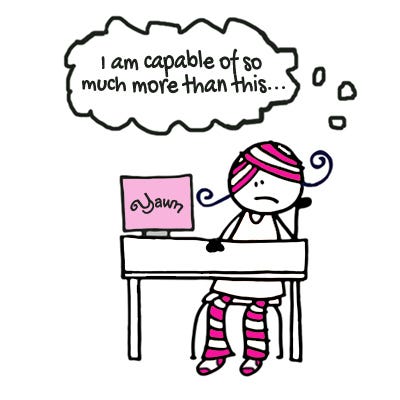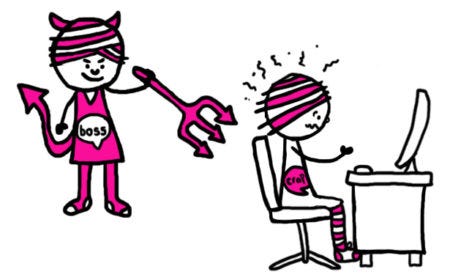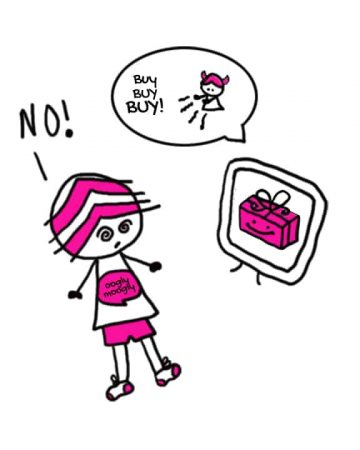So you’ve got your site up and running and you’re getting reasonable traffic from your well-written, thoughtful blog posts. You’ve even managed to accrue a mailing list with over 1000 actively interested folks clamoring for your next word. Finally, after months of effort, you’ve created a product you’re proud of, and you were eager to offer it to your hungry crowd.
And then… crickets.
Whaaaaat?!?! Not one sale? Or at best, anemic revenue numbers. How is this possible? You spent so much time, energy, and (probably) money investing in this endeavor. You did your research, you’ve done the work. This site is your ticket to breaking the shackles of working for other people, and your ticket to everlasting freedom! You know you can’t go back to that old life, you’d rather die first. But you have to pay the bills, irritatingly, or you might actually die.
And you did everything right, dammit. Right? RIGHT?!
So for the love of GOD, what is going ON?!??!
Well, I’ll tell you.
1. You’ve made it about you and not about them
You know how when you’re in a job interview, or on a date, all you’re thinking about is how much money you’re going to make at the job versus how much work you’re going to have to do for it?
Or how much time you’re going to have to put in with your date before you get to cop a feel?
In neither of these cases are you considering what the other person might need, in order to give you what you want.
The same concept applies to sales of your product. You must look at your product from the other person’s perspective, and make sure you can give them what they want, first, before you think about what you want from them: their money.
You must make it about them.
The key to making it about them is to be clear that your product will satisfy their personal needs.
The thing is, most folks think they actually know what the other person wants. And…. they don’t.
Most of us have a tendency to confuse situational needs with personal needs. They are very different and one has much more pulling power than the other.
Situational needs are superficial. Maybe your customer needs a car to get to work. Maybe she needs a class to show her how to program websites. Maybe he needs a new golf club to improve his game.
Whatever, these are boring.

But personal needs are… well… personal. They are the true core of why people buy things. They dig around in a person’s heart ❤️and fester there until the need is satisfied.
Maybe your customer needs a car that can not only get her to work, but that can pull a camper trailer around the country so she can feel free and mobile and alive.


Maybe he needs a new golf club to improve his game so he can realize a lifelong dream of playing at St. Andrews in Scotland without looking like a complete moron.

Simply offering something to your customers to solve a situational need may solve a basic problem, but nothing compares to their satisfaction of buying a thing to satisfy a personal need.
So figure out what your prospect’s personal needs are, and show them how you are going to give it to them. Listen to what they’re saying, and not saying.
Maybe you’re selling a weight loss product. Maybe you think all your customers are interested in with your product is to lose pounds.
But there is more to the equation. First of all, why should they believe you?
Have you really tapped into their needs? Have you really been in their shoes? Can you show them you know how exactly they feel?

Maybe on the surface all they want is to lose weight, but deep down what really they want is to feel better in, and about, their bodies. And even more likely so, they want to feel attractive to their gender of sexual interest.
It’s not just about losing pounds, although that’s might be true if you just stop there. But they also want to feel better. They want to maintain their weight loss, and stop the miserable cycle of fatness and dieting and deprivation and hunger. They want to attract sexual partners. They want to be there for their families.
So know your customer’s needs. Find out what’s really going on, and fulfill your prospect’s personal needs, first. Your time will come.
2. They’re more afraid than you realize
Everyone is familiar with this one. Commitment is scary.
Argh, I’m not sure I want to marry this person because what if he/she turns out to be a cokehead after five years?
Oh God, I don’t know if I should buy this car because what if all the wheels fall off five minutes after I leave the dealership?
Ummmm if I take this new job what happens if I’m bored out of my skull after six months or my boss turns out to be Satan in Sansabelt pants?

These are all valid concerns.
We are ALL afraid of making a commitment, to anything. There are no guarantees in life, and all of us have been burned at some point by pulling that trigger and having it blow up in our own faces.

Committing to something is always a risk.
Buying the wrong product, hiring the wrong person, going out on a date and having it be a big dull dud.
So the best thing you can do to alleviate this fear in your customers is either to offer refundable options, free trial periods, or some other creative way to make the transaction as risk-free as possible.
But the most important thing here to know is that people hesitate to “buy”, when they’re afraid of making a mistake that will hurt them later.
Find a way to show them that it won’t.
3. You haven’t convinced them they’ve finished shopping yet
When a customer is having that crushing mental debate over making a purchase, giving up other options is often not as noticeable during the transaction. Why? Because it happens on a deep psychological level.
As opposed to buying a product, I personally find the concept most glaring when it comes to marriage: what if I marry this guy and someone way more awesome comes along in a week? What could I be giving up??? Auuugggghgh!

Sometimes people do this when buying cars — they don’t want to give up their sports car when the time comes for a minivan, so any way they can find not to buy the minivan (and who wouldn’t NOT want to buy a minivan…) justifies their subconscious desire to keep the sports car. They simply don’t want to give up other possible options.
As said previously, making a commitment to anything is a scary prospect, for all the reasons already listed. But on top of those, you lose any other options you had going once the commitment is made, especially if the purchase is expensive, or has long-term consequences.
Ack!
It’s enough to make anyone drag their feet.

So remember this: you’re asking people to spend their money in a way that will most likely require that they don’t spend it somewhere else. When you are asking someone to give up the bank they would otherwise be using to fund a kegger, or a trip to Vegas, or a pair of Louboutin boots, or even your product for sale by someone else for less, you’d better have a really good reason.
It’s about making them willing to give up their other options because the option you’re offering them is SO MUCH BETTER.
How to overcome this resistance?
Make it about them and not you, and alleviate their fear of making a mistake.
Get past these two and everyone else’s offer will look like far crappier options than yours.

4. Your customer is worried: OMG what will my husband say?
Often times people resist buying a product if they think the other people in their lives won’t approve of the purchase. It sucks, but we’ve all done it.
If we think our spouse will freak out, our parents will moan, our boss will scream at us, our friends will laugh at us, it will bring the purchase process to a grinding halt.

So when you’re giving your “sales pitch”, make sure you keep in mind the important people in their lives that they want to impress (or otherwise avoid a negative response).
:: Remind your customer how much his mother is going to LOVE the new couch, so much that she’ll come over and sit on it every day (well… maybe don’t go that far….)!
:: Show your customer how his wife is going to be so proud of him for taking a class that will teach him how to earn more money for the family.
:: Describe to your customer how impressed with and desiring of you the chicks are going to be after using your new workout and diet program.
There are all kinds of ways you can show how a prospect’s circle of people will approve of what you’re trying to get them to do. Be creative!
5. Your customer is wondering: Am I going to feel stupid if I buy this thing?
No one wants to feel stupid. Even if they are stupid.

And for sure, no one wants their stupidity glaring them in the face every day.
Even the smartest people in the world don’t want to feel stupid for having bought your product.
We all know what it feels like to buy a car, right? Even today, with the “no haggle” bullshit line, we still feel like we’re getting ripped off, unless we get the car at a price that is w.a.a.a.a.y below what we think it’s worth.
THEN we think we’re frickin’ GENIUSES.
So there’s the solution to that problem: make the customer feel like a genius for buying your product. Sell it at a price that is way below what they will think it’s worth.
How do you do this?
Well, you can start by being really clear on the value of your product.
How do you do that?
Well….. show the customer how it will fulfill their personal needs, that the transaction will be risk-free, that there really is no better option out there, and that they’ll get cheers of pride from their entourage when they show them what they bought.
See how that works? 🙂
Then, you can give them a price that you know is far less than all that value you just displayed to them.
But don’t let the phrase “far less” scare you. Price is all relative to perceived value. So if you’ve done the first four steps well, you can sell your product for thousands of dollars and people will still feel like geniuses for having bought it.
Wheeeeee! #Winning!

6. You still have to prove you’re worth it
Sometimes your price is just too high for some people. They like the idea of your product, but they still don’t think it’s worth the price you’re charging.
On the one hand, it’s possible that these people are not really your market. They may just be interested by-standers. If so, you might need to rethink your intended audience.
On the other hand, if you’ve got interested parties who keep coming back to your site for more, and yet they still don’t buy anything, it’s reasonable to suggest they feel that way because the first five reasons have not been satisfied.
The price is just the final nail in the coffin.
Price is rarely sole the reason people don’t buy something. It’s generally the first two, and then the following three a close second.
These emotional blocks are very strong.
But the perceive cost (price) of what you’re selling can be the final and impassable roadblock if all the other above reasons have not been satisfactorily dealt with. Your prospect will just say “the price is too high”.
How do you get around that?
Make sure you’re meeting your customer’s personal needs, you’ve eliminated any fear of making a purchase mistake, you’ve shown them you’re the best option going for their money, you’ve proven that their important people will approve, and you’ve made them feel like a genius for buying your product.
If they still think the price is too high, then they’re not your customer. Find your fans.

Because your price is worth it.
So you’ve carefully absorbed and processed this post, made some adjustments to your product offerings and sales copy, and the next thing you know:
OMG you got your first online sale! And then another, and another, and another!
OH. EM. GEE.
Ohhhhh, the bliss of seeing this thing you’ve created take off is simply immeasurable.
Not to mention the relief.
Imagine no more worrying about having to go back to your horrible job with your horrible boss. No more missing time with your kids because you had to work late for said horrible boss. No more worrying about not being able to pay the mortgage and having to live in a van by the river.
All the joy, none of the pain. Why? Because you’ve got this. Now you know your customers’ resistances and what to do to move them out of indecision (or, you know, repulsion) and into a purchase. And you know you can do this again, and again, and again. Whoo hoo!
Imagine all that. But who are we kidding? You’ve already imagined all that, that’s why you started your business in the first place: to experience that kind of heaven. Welcome home!








